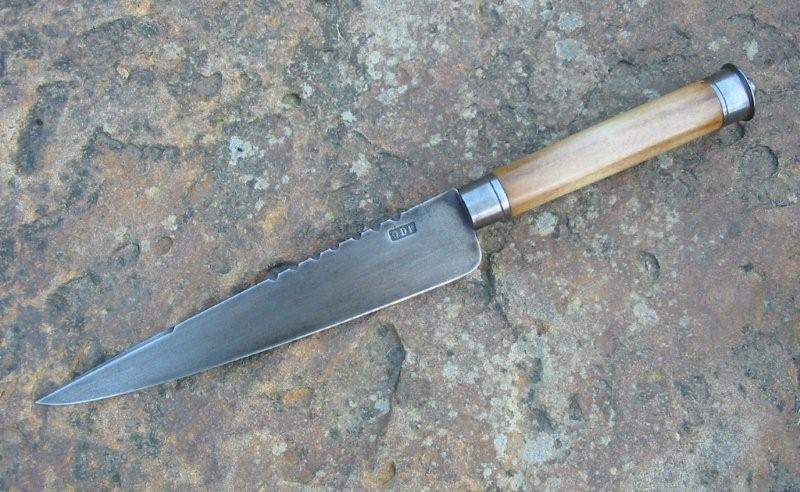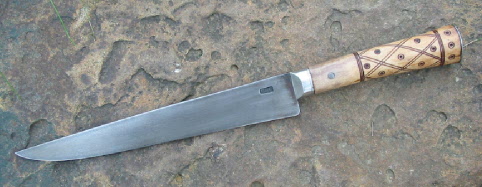I just got one of these blades: https://www.atlantacutlery.com/scottish-dirk-blade-blanks to use in a DIY project eventually.
This is one of the surplus/discontinued blades Atlanta Cutlery is now selling. Actual dimensions are 12 1/4" long blade, 1/4" thick at the base. Pretty good quality for the price, filework particularly looks great.
I really liked the blade when I saw it, and decided that at this price it makes sense to just buy it and then figure out how to mount it. The catch is that I don't like proper Scottish Dirk handles at all!
Can you think of some kind of different "plausibly historical" handle style for this kind of blade?
I was thinking about something like early bollock dagger, or maybe rondel dagger handle. Don't see these as quite the right match for the blade in my mind, though.
So far I am leaning toward some purely "fantasy" handle, with no historical pedigree. Something with small guard/pommel, suitable for both forward and reverse grip, simple lines but with some decorative materials to keep up with the filework on blade.
My current project will probably keep me occupied for a couple months at least, so I have time to consider design for the Dirk blade. Any ideas are welcome in the mean time!
Hi,
Possibly something along these lines https://auctions.lyonandturnbull.com/auction-lot-detail/A%2DSCOTTISH%2DLOWLAND%2DDIRK%2DCIRCA%2D1830%2D35cm%2Dlong/530++++++631+/++227191
Regards,
Norman.
Possibly something along these lines https://auctions.lyonandturnbull.com/auction-lot-detail/A%2DSCOTTISH%2DLOWLAND%2DDIRK%2DCIRCA%2D1830%2D35cm%2Dlong/530++++++631+/++227191
Regards,
Norman.
Dang, I ordered one of those too, but they sent me a different one that was much thinner. You may have gotten the last one :D
I'm planning on one of those Lowland dirks once I get a suitable blade. Apparently they were known as "whingers."
I'm planning on one of those Lowland dirks once I get a suitable blade. Apparently they were known as "whingers."
Colonial American knife forms would be another good option. Check out some of Kyle Wilyard's work: http://www.olddominionforge.com/knives.html
But for this blade I'm thinking specifically of a type of late 18th c. American knife with a thin oval guard and straight grip of oval section, with a cap and grip inlay of steel, silver or nickel. It's in Flayderman's Bowie book but I'm not seeing it online because I don't remember the name of the maker.
I thought about getting one of those blades for just such an early American knife project.
But for this blade I'm thinking specifically of a type of late 18th c. American knife with a thin oval guard and straight grip of oval section, with a cap and grip inlay of steel, silver or nickel. It's in Flayderman's Bowie book but I'm not seeing it online because I don't remember the name of the maker.
I thought about getting one of those blades for just such an early American knife project.
Any of these ODF treatments would look great with that Scottish blade.
 Attachment: 85.95 KB
Attachment: 85.95 KB

 Attachment: 36.27 KB
Attachment: 36.27 KB

 Attachment: 21.72 KB
Attachment: 21.72 KB




Ahhh, yes...here's the one I had in mind for a project with your Windlass blade. Eliminate the bling and you'd still have a gorgeous knife.
https://www.morphyauctions.com/jamesdjulia/item/2254-391/
 Attachment: 75.55 KB
Attachment: 75.55 KB

https://www.morphyauctions.com/jamesdjulia/item/2254-391/

Hey, these are great replies!
Sean, I don't think your "Colonial American knife forms" would work well with this blade. Simply because they require handle to be located up towards the back of the blade rather than on center line where the Dirk's tang is.
But the "whinger" idea is just what I was looking for!
Somehow I never heard of this type at all. The pictures in the linked topic are very informative, including scabbards/suspension/by-knives/etc. I will probably end up mounting it in this fashion, with mild steel fittings and black wood for grip.
There is only one detail I am not happy with - all the "whingers" pictured seem to have round grips, which isn't good for edge alignment. On a blade like this, wide enough for effective cutting, I would consider edge alignment an important consideration.
Do you think making the grip octagonal or at least oval in cross section would be too much out of character?
Sean, I don't think your "Colonial American knife forms" would work well with this blade. Simply because they require handle to be located up towards the back of the blade rather than on center line where the Dirk's tang is.
But the "whinger" idea is just what I was looking for!
Somehow I never heard of this type at all. The pictures in the linked topic are very informative, including scabbards/suspension/by-knives/etc. I will probably end up mounting it in this fashion, with mild steel fittings and black wood for grip.
There is only one detail I am not happy with - all the "whingers" pictured seem to have round grips, which isn't good for edge alignment. On a blade like this, wide enough for effective cutting, I would consider edge alignment an important consideration.
Do you think making the grip octagonal or at least oval in cross section would be too much out of character?
I wouldn't hesitate to use a chamferred rectangle or other faceted shapes on a knife of that period. As you see, there are many variants of material and construction, including the relatively weak half-tang design. The Whinger appears to be an artistic nod to the old ballock/dudgeon family, but with the tastes of the early 19th c. You wouldn't be treading on any historical graves by adapting it.
You could use a turned tool handle as-is or rasp/sand flats or facets as you wish. https://www.ebay.com/i/153244984611?chn=ps
Keep in mind, too, that a centered tang doesn't have to go through the dead center of the handle. For that early American knife I posted, you could locate the tang hole off center towards the back of the blade. There's a limit to that, but I think you could get enough offset for it to look right with a guard.
You could use a turned tool handle as-is or rasp/sand flats or facets as you wish. https://www.ebay.com/i/153244984611?chn=ps
Keep in mind, too, that a centered tang doesn't have to go through the dead center of the handle. For that early American knife I posted, you could locate the tang hole off center towards the back of the blade. There's a limit to that, but I think you could get enough offset for it to look right with a guard.
| Sean Flynt wrote: |
| ... The Whinger appears to be an artistic nod to the old ballock/dudgeon family, but with the tastes of the early 19th c.
... you could locate the tang hole off center towards the back of the blade. There's a limit to that, but I think you could get enough offset for it to look right with a guard. |
Actually the Whingers published in the linked topic are dated 16th-17th c., so the type isn't a 19th c. artistic invention.
I played with measurements for offsetting the tang on this blade myself, but concluded that to make it work either the tang would have to be narrowed down way too much, or there would be almost no handle material left at the bottom edge of tang. So for me at least it didn't work out.
Ah, yes. I missed that original thread and just saw the later example linked above. Very cool things.
Page 1 of 1
You cannot post new topics in this forumYou cannot reply to topics in this forum
You cannot edit your posts in this forum
You cannot delete your posts in this forum
You cannot vote in polls in this forum
You cannot attach files in this forum
You can download files in this forum
All contents © Copyright 2003-2006 myArmoury.com — All rights reserved
Discussion forums powered by phpBB © The phpBB Group
Switch to the Full-featured Version of the forum
Discussion forums powered by phpBB © The phpBB Group
Switch to the Full-featured Version of the forum